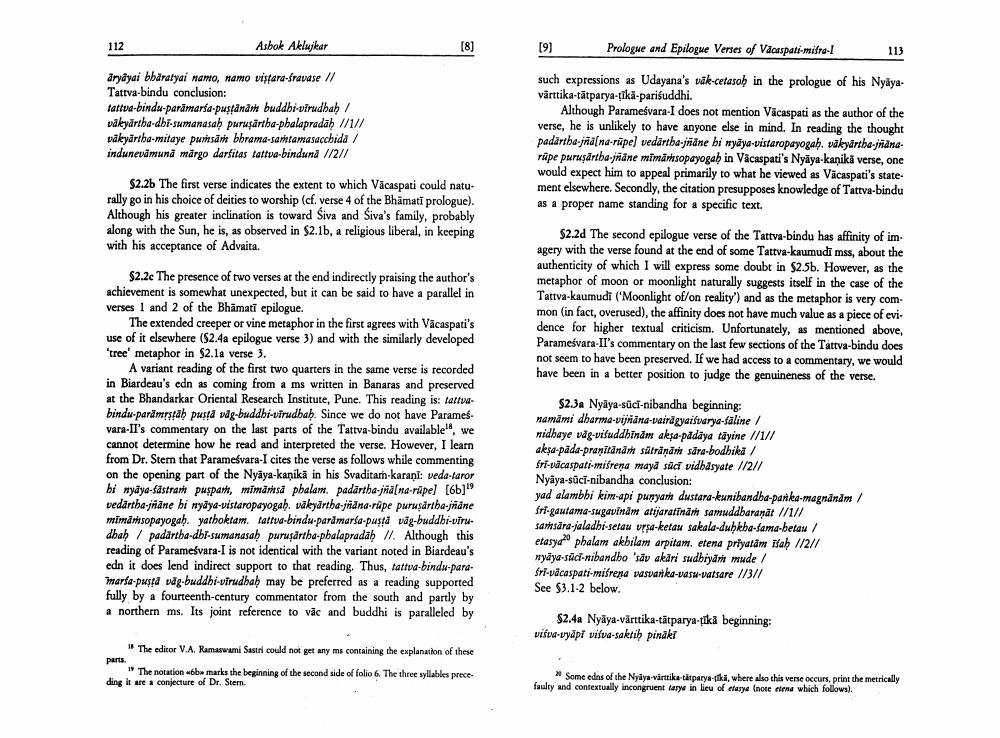Book Title: Prologue And Epilogue Verses Of Vacaspati Misra I Author(s): Ashok Aklujkar Publisher: Ashok Aklujkar View full book textPage 5
________________ 112 Asbok Aklujkar (8) 19) Prologue and Epilogue Verses of Vacaspati-mifra. 113 aryayai bbdratyai namo, namo vistara-fravase // Tattva-bindu conclusion: tattua-bindu.paramarsa.pusfandne buddhi-virudhah / pákyrtha-dbi-sumanasab puruşartha-phalapradah //1/1 páky ribemitaye puntsante bbrama-santamasacchida/ induneuland märgo darsitas tatua-bindund //2// such expressions as Udayana's vāk-cetasoh in the prologue of his Nyāyavårttika-tātparya-çika-parifuddhi. Although Parameśvara-I does not mention Vacaspati as the author of the verse, he is unlikely to have anyone else in mind. In reading the thought padartha-na na-rūpe) vedartha-jñāne bi nyaya-vistaropayogab. vákyrtha-ridnarape puruşartha-ridne mimdsopayogah in Vacaspati's Nyāya-kaniki verse, one would expect him to appeal primarily to what he viewed as Vacaspati's statement elsewhere. Secondly, the citation presupposes knowledge of Tattva-bindu as a proper name standing for a specific text. $2.26 The first verse indicates the extent to which Vacaspati could naturally go in his choice of deities to worship (cf. verse 4 of the Bhämati prologue). Although his greater inclination is toward Siva and Siva's family, probably along with the Sun, he is, as observed in $2.1b, a religious liberal, in keeping with his acceptance of Advaita. $2.2d The second epilogue verse of the Tattva-bindu has affinity of imagery with the verse found at the end of some Tattva-kaumudi mss, about the authenticity of which I will express some doubt in $25b. However, as the metaphor of moon or moonlight naturally suggests itself in the case of the Tattva-kaumudi ("Moonlight of/on reality') and as the metaphor is very common (in fact, overused), the affinity does not have much value as a piece of evidence for higher textual criticism. Unfortunately, as mentioned above, Paramešvara-II's commentary on the last few sections of the Tattva-bindu does not seem to have been preserved. If we had access to a commentary, we would have been in a better position to judge the genuineness of the verse. $2.2c The presence of two verses at the end indirectly praising the author's achievement is somewhat unexpected, but it can be said to have a parallel in verses 1 and 2 of the Bhämati epilogue. The extended creeper or vine metaphor in the first agrees with Vacaspati's use of it elsewhere ($2.4a epilogue verse 3) and with the similarly developed 'tree' metaphor in $2.la verse 3. A variant reading of the first two quarters in the same verse is recorded in Biardeau's edn as coming from a ms written in Banaras and preserved at the Bhandarkar Oriental Research Institute, Pune. This reading is: tattwa. bindu.paramsa pusta wag-buddhi-virudhah. Since we do not have Parames. vara-II's commentary on the last parts of the Tattva-bindu available", we cannot determine how he read and interpreted the verse. However, I learn from Dr. Stern that Paramesvara-I cites the verse as follows while commenting on the opening part of the Nyaya-kanikā in his Svaditam karani: wede-taror bi nyaya-Sastrant puspart, minded phalan. padartha-jrid (na-rapel (6b)" vedantharidne bi nyaya-vistaropayogah. vakartharina-rape purustajridne mimantusopayogah. yathoktam. tattw-bindu-pardmarla pused wg-buddbi-viru. dbah / padartha-di-sumanasah puruşartha-pbalapradah II. Although this reading of Parameśvara-I is not identical with the variant noted in Biardeau's edn it does lend indirect support to that reading. Thus, tattua-bindu-paraImarfa.pusta wig buddhi-virudhah may be preferred as a reading supported fully by a fourteenth-century commentator from the south and partly by a northern ms. Its joint reference to vāc and buddhi is paralleled by $2.3a Nyāya-suci-nibandha beginning: namami dharma-vijana-vairagrafuara-saline / nidhaye våg-vifuddhinam aksa-padāya tāyine //// aksa-pada-pranitānām sätraņām sāra-bodhikt / fri-vdcaspati-misrena mayd sad vidhasyate 1/2// Nyaya-sūci-nibandha conclusion: yad alambbi kim-api punyaris dustara-kunibandha-parka-magnândm fri-gantama-sagavind me atijaratinānis samuddbaranat /1// sansara-jaladhi-setan urfa-ketas sakala-dubkba-fama-betas / etasya phalam akhilam arpitam. etena priyatam ifah //2// wyda-sad-nibandho 'sav akari sudbryant mude/ fri-vicaspati-mifrena wasvan ka-vasu-vatsare 1/3// See $3.1-2 below. $2.4a Nyāya-värttika-tātparya-tika beginning: vift-wyāpi visva-saktib pinaki "The editor V.A. Ramaswami Sastri could not get any ms containing the explanation of these parts. The notation wóbw marks the beginning of the second side of folio 6. The three syllables prece ding it are conjecture of Dr. Stern Some edns of the Nydya vinttika tatparya-ka, where also this verse occurs, print the metrically faulty and contextually incongruent tasya in lieu of etarye (note nena which follows).Page Navigation
1 ... 3 4 5 6 7 8 9 10 11 12 13 14
